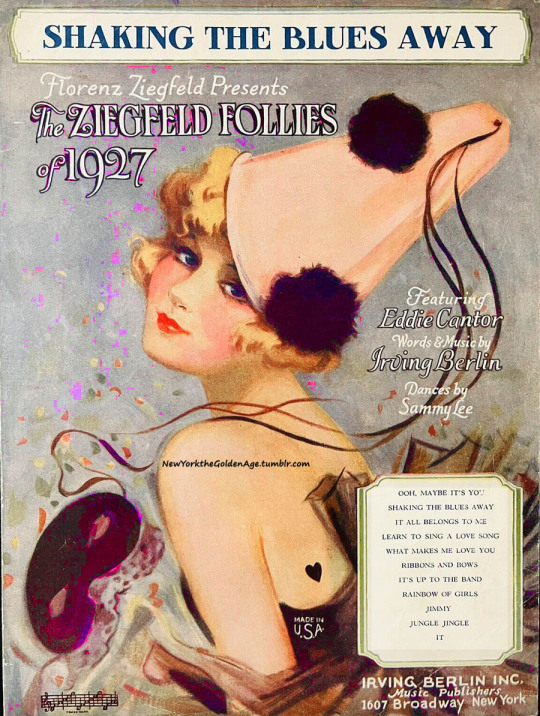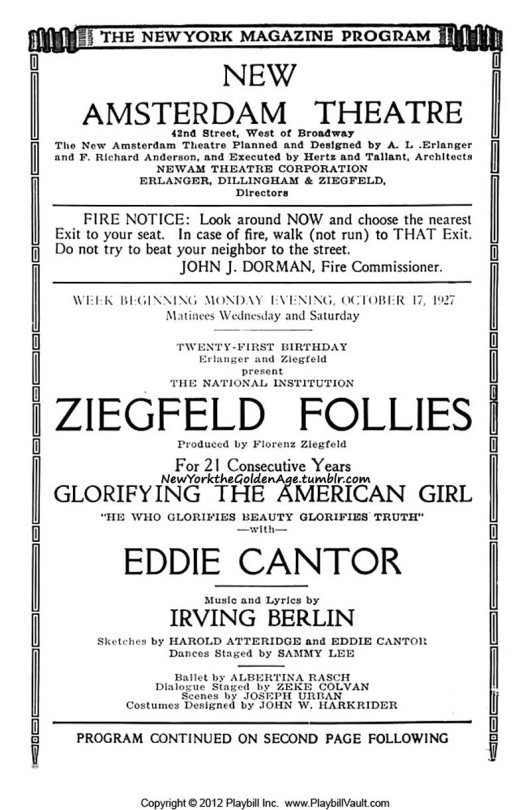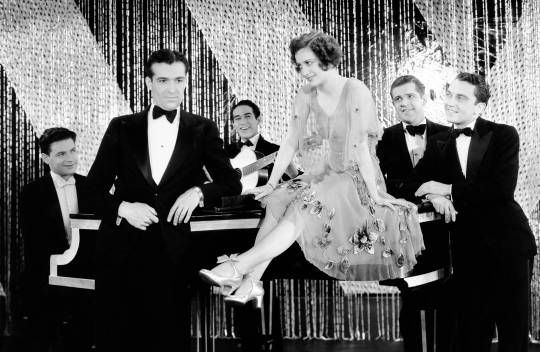#Brox Sisters
Explore tagged Tumblr posts
Text

Above: the sheet music for Shakin' the Blues Away. Photo: ebay
The Ziegfeld Follies of 1927 was the first Follies to feature a star performer--Eddie Cantor--and the first to have all its songs written by a single composer--Irving Berlin. Although it received tepid reviews ("His formula has never failed," wrote Time magazine. "But as nothing subscribes more unreservedly to the law of diminishing returns than [a] succession of splendors, this last superbly heralded Follies achieves only another anticlimax."), it was a hit, running for 167 performances from 1927-28.
In addition to Cantor (who appeared in nearly half the numbers), the show featured Claire Luce, Cliff Edwards (aka Ukelele Ike; 13 years later he was the voice of Jiminy Cricket in Disney's Pinocchio), Ruth Etting, and the Brox Sisters.
"Shakin' the Blues Away" was the show's big number, and Etting made her breakout appearance leading it.

Above: Shakin' the Blues Away, led by Ruth Etting. Photo: Songbook
There was also a jungle scene with live animals, in which Luce entered riding an ostrich. One night the bird left the stage in a flurry and, instead of depositing Luce in the wings, kept on walking, out the stage door and onto West 43rd St.
Below is the first page of the program for the October 17, 1927 performance. Note the sententious legend, "He who glorifies beauty glorifies truth." Would Keats have approved?

Above: the first page of the program for Oct. 17, 1927. Photo: Playbill
The 1927 Follies was the last of 21 annual shows. It was revived briefly in 1931, but didn't continue. The Follies were essentially vaudeville, only much more sumptuous. Later in 1927, Ziegfeld produced Show Boat at his own theater, and it heralded a change in Broadway musicals.
#vintage New York#1920s#Florenz Ziegfeld#Ziegfeld Follies#musical revues#Follies#Broadway musicals#vintage Broadway#Eddie Cantor#Irving Berlin#Claire Luce#Ruth Etting#Ukelele Ike#Brox Sisters
116 notes
·
View notes
Text

1930 The singing Brox Sisters. From The Forgotten Splendour, FB.
122 notes
·
View notes
Text
I am Mildly Annoyed that whosampled links the Al Jolston version of Lazy as the original song TMBG covered, when they said they were inspired by the Brox Sisters version with the extra lyrics in the bridge, which the Jolston version doesn't have
4 notes
·
View notes
Photo

Joan Crawford in The Hollywood Revue of 1929 (Charles Reisner, 1929)
Cast: Conrad Nagel, Jack Benny, Norma Shearer, John Gilbert, Joan Crawford, Bessie Love, Cliff Edwards, Stan Laurel, Oliver Hardy, Anita Page, Nils Asther, Marion Davies, William Haines, Marie Dressler, Charles King, Buster Keaton. Screenplay: Al Boasberg, Robert E. Hopkins. Cinematography: John Arnold, Max Fabian, Irving G. Ries. Art direction: Erté. Film editing: William S. Gray, Cameron K. Wood. Music: Arthur Lange.
Designed to show off the novelty of sound and, in two sequences, the coming novelty of Technicolor, The Hollywood Revue of 1929 was enthusiastically received by critics and audiences, though it lost the best picture Oscar to The Broadway Melody (Harry Beaumont, 1929). Today, both movies are creaky antiques, despite the effort that MGM put into producing them. In fact, The Hollywood Revue often seems like an attempt to promote The Broadway Melody, which had opened three and a half months earlier, since it gives prominent spots to that film's stars, Charles King, Bessie Love, and Anita Page. The rest of it feels a lot like amateur night at MGM, as the studio's stars are trotted out for songs and skits that often feel tired and incoherent. In a few years, MGM would be boasting that it had more stars than there are in Heaven, but many of the stars showcased in the Revue are forgotten today -- like King, Love, and Page -- or were on the wane -- like John Gilbert, Marion Davies, and Buster Keaton. The ones that remained stars, like Jack Benny and Joan Crawford, did so by reinventing themselves. The Revue, which modeled itself on theatrical conventions like the minstrel show and vaudeville, both of which were on the outs, failed to break ground for the Hollywood musical. It would take a few years for Warner Bros. to do that, with 42nd Street (Lloyd Bacon, 1933) and the unfettered imagination of Busby Berkeley taking the backstage musical formula of The Broadway Melody and some of Sammy Lee's choreographic tricks from the Revue -- including overhead kaleidoscope shots -- and improving on them. The Revue has a few highlights even today: Joan Crawford trying a little too hard to sparkle as she sings (passably) and dances (clunkily); Stan Laurel and Oliver Hardy in their first sound film, doing a magic act with Jack Benny's intervention; Cliff Edwards and the Brox Sisters doing "Singin' in the Rain," which gets a Technicolor reprise with most of the company at the film's end; Keaton acrobatically clowning his way (silently) through an "underwater" drag routine; and Norma Shearer and John Gilbert in Technicolor performing a bit of the balcony scene from Romeo and Juliet, first as Shakespeare wrote it and then in 1929's slang. To get to them, however, you have to sit through a lot of dud routines and dated songs like Charles King's paean to maternity, "Your Mother and Mine," which must have been aimed right at the mushy heart of that ardent defender of motherhood, Louis B. Mayer.
4 notes
·
View notes
Text
SINGIN' IN THE RAIN - GENE KELLY
Canción de 1952 interpretada por el actor, cantante y bailarín estadounidense Gene Kelly ( Eugene Curran Kelly ) en la película Cantando Bajo La Lluvia ( Singin' In The Rain ). Escrita originalmente por Arthur Freed y Nacio Herb Brown y grabada por primera vez en 1929 para la comedia musical The Hollywood Revue Of 1929 interpretada por The Brox Sisters.
1 note
·
View note
Photo


Brox [Sisters] (LOC)
Brox Sisters
227 notes
·
View notes
Text
BANJOLELE TIME!
Since I’ve gathered most of the music of “Jeeves And Wooster”, it’s time for a deep dive into the banjolele songs in “Thank You, Jeeves” (1934)
“I played five bars of ‘Old Man River’ with something of abandon.”
Legend Paul Robeson singing ‘Old Man River’ in “Showboat”. Wodehouse co-wrote the lyrics of many of the songs, including the legendary “Bill”.
youtube
“With a good deal of quiet self-satisfaction I proceeded to play ‘The Wedding of the Painted Doll’, ‘Singin’ In the Rain’, ‘Three Little Words’, ‘Good Night, Sweetheart’, ‘My Love Parade’, ‘Spring Is Here’, ‘Whose Baby Are You’, and part of ‘I Want an Automobile With a Horn That Goes Toot-Toot’, in the order named.”
(Poster’s note: OOF! This is going to take several posts!!)
youtube
“The Wedding Of The Painted Doll”, Broadway Melody of 1929
Next up, two clips from “The Hollywood Revue of 1929″, a musical revue from MGM. The first musical number features Cliff “Ukelele Ike” Edwards, accompanied by the Brox Sisters.
youtube
The second clip is the finale of the movie, shot in Two-Strip Technicolor. Color photography in those days required lights bright enough to blind the performers and made the soundstage unbearably hot. And I don’t know why an arc is behind them! The entire cast is there. The roster of MGM stars includes, as far as I can tell, starting from left to right 1) George K. Arthur, Joan Crawford. Marion Davies, Buster Keaton (not singing) . 2) Brox Sister?, Cliff Edwards, Brox Sister?, , ?, Conrad Nagel (master of ceremonies), Bessie Love, Charles King, Marie Dressler, ?, Polly Moran
youtube
#hollywood revue of 1929#jeeves and wooster#thank you jeeves#banjolele#this is a fuck of a lot of songs#buster keaton#joan crawford#cliff edwards#brox sisters#marion davies#conrad nagel#marie dressler#polly moran#paul robeson#old man river#show boat#the wedding of the painted doll#broadway melody of 1929#1929#musicals#p.g. wodehouse#he wrote song lyrics
7 notes
·
View notes
Photo

The Brox Sisters were an American trio of singing sisters, enjoying their greatest popularity in the 1920s and early 1930s.
46 notes
·
View notes
Photo
Designed to show off the novelty of sound -- and, in two sequences, the coming novelty of Technicolor -- The Hollywood Revue of 1929 was enthusiastically received by critics and audiences, though it lost the best picture Oscar to The Broadway Melody (Harry Beaumont, 1929). Today, both movies are creaky antiques, despite the effort that MGM put into producing them. In fact, The Hollywood Revue often seems like an attempt to promote The Broadway Melody, which had opened three and a half months earlier, since it gives prominent spots to that film's stars, Charles King, Bessie Love, and Anita Page. The rest of it feels a lot like amateur night at MGM, as the studio's stars are trotted out for songs and skits that often feel tired and incoherent. In a few years, MGM would be boasting that it had more stars than there are in heaven, but many of the stars showcased in the Revue are forgotten today -- like King, Love, and Page -- or were on the wane -- like John Gilbert, Marion Davies, and Buster Keaton. The ones that remained stars, like Jack Benny and Joan Crawford, did so by reinventing themselves. (Or, like Norma Shearer, had the help of a powerful husband, Irving Thalberg.) The Revue, which modeled itself on theatrical conventions like the minstrel show and vaudeville, both of which were on the outs, failed to break ground for the Hollywood musical: It would take a few years for Warner Bros. to do that, with 42nd Street (Lloyd Bacon, 1933) and the unfettered imagination of Busby Berkeley taking the backstage musical formula of The Broadway Melody and some of Sammy Lee's choreographic tricks from the Revue -- including overhead kaleidoscope shots -- and improving on them. The Revue has a few highlights even today: Joan Crawford trying a little too hard to sparkle as she sings (passably) and dances (clunkily); Stan Laurel and Oliver Hardy in their first sound film, doing a magic act with Jack Benny's intervention; Cliff Edwards and the Brox Sisters doing "Singin' in the Rain," which gets a Technicolor reprise with most of the company at the film's end; Keaton acrobatically clowning his way (silently) through an "underwater" drag routine; and Norma Shearer and John Gilbert in Technicolor performing a bit of the balcony scene from Romeo and Juliet, first as Shakespeare wrote it and then in 1929's slang. To get to them, however, you have to sit through a lot of dud routines and dated songs like Charles King's paean to maternity, "Your Mother and Mine," which must have been aimed right at the mushy heart of Louis B. Mayer.

Norma Shearer and John Gilbert
29 notes
·
View notes
Video
youtube



Brox Sisters(1920′s)
#1920s#20s#roaring twenties#roaring 20s#history#vintage photography#vintage music#music#20s music#brox sisters#red hot mama#vintage#girls#girl band
2 notes
·
View notes
Video
youtube
“Singin’ in the Rain” de Brox Sisters, de la película “The Hollywood Revue of 1929″ (1929).
2 notes
·
View notes
Video
youtube
“I´m Lonely Without You” de The Brox Sisters, single (Vaudeville, Estados Unidos, 1926).
3 notes
·
View notes
Photo

The Brox Sisters tuning their radio, ca. 1920s
#1920s#1920s fashion#vintage fashion#vintage#radio#singer#library of congress#item 2014717186#bain collection#photo edit
198 notes
·
View notes
Photo

The Brox sisters, ca. 1920
103 notes
·
View notes
Text

The Brox Sisters, Lorayne, Bobbie and Patricia, c.1920s.
91 notes
·
View notes
Text



The Brox Sisters were an American trio of singing sisters, enjoying their greatest popularity in the 1920s and early 1930s. The sisters were: Lorayne (born Eunice 1901 – 1993) Bobbe or Dagmar (born Josephine Brock 1902 – 1999) & Patricia (born Kathleen 1904 – 1988).
They began in the 1910s touring the Vaudeville circuit in the United States and Canada. At the start of the 1920s they achieved success in New York on the Broadway stage. They were featured in the Ziegfeld Follies of 1927. Near the end of the decade they relocated to Los Angeles.
The act broke up in the early 1930s after the sisters got married. They made their final professional reunion appearance on radio in 1939.
#BroxSisters #ZiegfeldFollies1927 #FricPic
81 notes
·
View notes